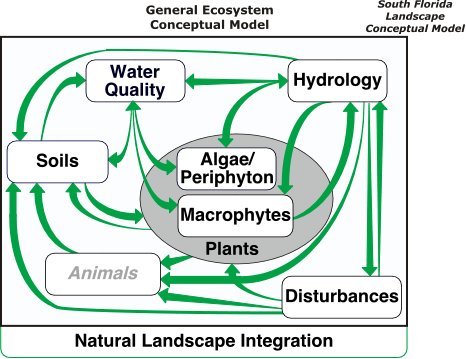![]() Background |
Models |
Projects |
Publications |
People |
News
Background |
Models |
Projects |
Publications |
People |
News
![]() Background |
Models |
Projects |
Publications |
People |
News
Background |
Models |
Projects |
Publications |
People |
News
Introduction
Wetlands & ecological models
Conceptual model: South Florida
Generic modeling framework

Macrophytes are a primary determinant of the habitat quality in the Everglades landscape, which is largely defined by its heterogeneous mosaic of macrophytic vegetation that is dynamic over both annual and decadal time scales.
There is a high diversity of plants in this region, ranging from emergent marsh plants such as the ubiquitous sawgrass, to hardwood trees of tree islands and mangrove forests. These, and many other common species, form a wide variety of plant communities with very different nutrient requirements, distinct hydrologic needs, and dynamic effects on the hydrologic cycle itself.
Different adaptations by these plants create the habitat mosaic in response to a changing environment. For example, cattail is a "nuisance" species that grows rapidly in response to elevated nutrient availability, has morphological characteristics that allow it to thrive in flooded conditions, and easily colonizes areas that have been disturbed by man-made or natural events. Sawgrass, on the other hand, is a very dominant species in much of the Everglades where there are oligotrophic (low nutrient) conditions and "natural" fluctuations of water levels and disturbances.
With mortality or dieback of leaves and roots of these plants comes the accumulation of organic matter in the form of peat soils. Tree islands have "died" in recent years due not only to excessive water depths covering tree roots for prolonged periods, but also due to fires in regions that have been overdrained and made more susceptible to catastrophic disturbance.
Where regions of the Everglades have undergone successional shifts in plant communities, animal communities invariably are affected. Many animals are adapted to, and rely upon, high quality habitats that are often characterized by the heterogeneous, alternating distributions of dense and sparse vegetation of different species.
 EcoLandMod Background
EcoLandMod Background